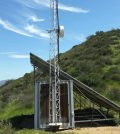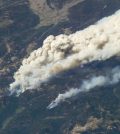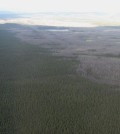Posts for tag "forest fire"
Predicting and Responding to Wildfires: Canada’s Scientific Approach to Fire Management
High temperatures and prolonged dry spells lead to increased chances of wildfires sparking across the world. In order to combat fires, federal and local governments have developed fire management programs and policies to prevent and respond to...
- Posted July 31, 2023
Researchers Find Link Between Forest Fires And Health
Researchers at UC Berkeley found that allowing, not suppressing forest fires, can improve tree health and help water spread through Yosemite National Park.
- Posted March 1, 2017
Predicting Wildfire Movement With Multiparameter Weather Sensors
A network of multiparameter weather sensors in California helps keep the Sunrise Powerlink clean energy line safe from California wildfires.
- Posted September 9, 2016
Burning Permafrost: Handheld Water Quality Meters Track Impacts
Peristaltic pumps and handheld water quality meters aid Woods Hole Research Center scientists studying impacts of fire to Yukon River Delta permafrost.
- Posted September 8, 2016
Western Cameras Capture Hot Pot Wildland Fire
A growing network of cameras are monitoring wildfires in the West. Some recently helped responders put out the Hot Pot Wildland Fire.
- Posted July 27, 2016
How Are Waterfowl Affected By Wildfires?
Waterfowl affected by wildfires in North America’s boreal forest are remarkably resilient to the blazes, U.S. Geological Survey scientists find.
- Posted July 21, 2016
Wildfires Cause Surges In Erosion Rates On Forested Mountains
Researchers from the University of Arizona did before-and-after studies of how severe wildfires affect erosion rates.
- Posted May 31, 2016
Warmer Arctic Likely Contributing To Canada Wildfires
Scientists from Rutgers University believe there is a link between warmer conditions in the Arctic and the wildfires seen in Canada this year, according to Phys.org. The fires have raged in parts of the province of Alberta,...
- Posted May 27, 2016
Expanding Camera Network Protects Lake Tahoe From Wildfires
An expanding network of cameras around Lake Tahoe is revolutionizing the fight against wildfires there, according to the Associated Press. That is largely because they can be operated by anyone online, instead of requiring expensive survey flights...
- Posted May 17, 2016
Camera Networks Expanding To Keep Eye On Western Wildfires
A number of expanding camera networks across the U.S. West are key for tracking the beginning and spread of wildfires.
- Posted April 28, 2016
AlertSoCal Camera Network Aids Wildfire Prediction In Southern California
A network of mountaintop cameras, called the AlertSoCal system, operated by researchers at Scripps Institution of Oceanography offers a new opportunity for early detection of fire hazards in some of the most remote locations in Southern California,...
- Posted April 18, 2016
Drought Conditions Impact Post-Fire Recovery Of Rocky Mountain Trees
While many tree species are well adapted to fire, recently Rocky Mountain trees have had more difficulty recovering from fire than in the past, according to a release from the University of Wisconsin-Madison. Scientists at the university...
- Posted April 11, 2016
Increase In Australian Bushfires Points To Changing Climate
Bushfires in Australia have been increasing since the 1970s, with significant increases shown from the 1990s to 2000s. All data points to a trend of more bushfires, and, since 2011 alone, bushfires have increased a staggering 40...
- Posted February 19, 2016
NASA Makes Push For Firesat, A Global Wildfire Detection System
A team at NASA’s Jet Propulsion Laboratory is working to bring about a network of space-based sensors that could conceivably locate and track wildfires all across the globe, according to a release from the agency. They are...
- Posted November 24, 2015
USGS Scientists Create Models To Predict Soil Erosion Risk After Wildfires
A synthesis of GIS soil erosion models and future fire-risk models yields projections of post-wildfire erosion risks for western U.S. watersheds.
- Posted November 23, 2015
Arizona Researchers To Dissect Impacts Of Arctic Wildfires
A new study is focused on recent severe wildfires in the Arctic, according to a release from Northern Arizona University. NASA is funding a 10-year, $100-million project to measure severe fire impacts in North America. The Arctic...
- Posted October 27, 2015
Boreal Wildfires A Net Source Of Atmospheric Carbon
A study by scientists at the University of Illinois has shown that boreal wildfires, like those in Alaska’s Yukon Flats, have turned these ecosystems into net sources of atmospheric carbon, according to a release. The team examined...
- Posted October 26, 2015
Modeling Tool Helps Minimize Flood And Landslide Risks After Wildfires
A tool in development at Michigan Tech Research Institute looks to minimize risks of landslides and flooding after wildfires clear out trees and soil cover.
- Posted September 10, 2015
California Forest Fires Create Conditions Promoting Southern Plant Species Abundance
A study of 12 Californian wildfires found that plant species associated with a southern distribution grew more abundant than northern species post-fire.
- Posted August 19, 2015
Landsat 8 Images Pinpoint Cheatgrass Stands, Idaho Wildfire Risk
Using Landsat 8 satellite imagery, scientists at Idaho State University have discovered increasing wildfire susceptibility in large portions of eastern Idaho, according to a release from the school. The cause for the increased risk, they say, is...
- Posted August 17, 2015






















